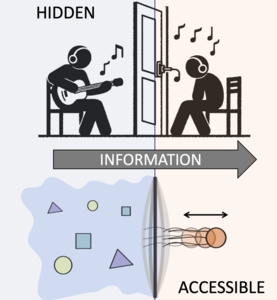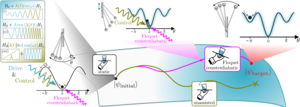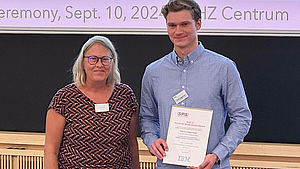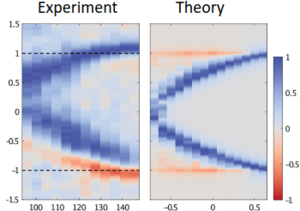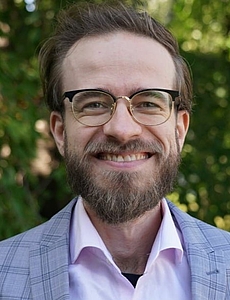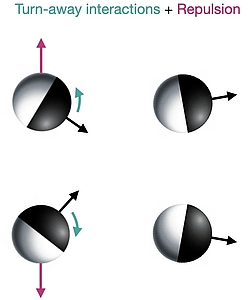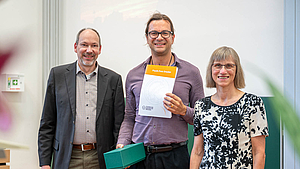
Highlights
Publication Highlights
Listening to hidden signals: how biological systems optimise inaccessible information
Living organisms must sense and process information from their surroundings to survive, but they often cannot directly “listen” to external signals. For example, the internal processes of a red blood cell can only access the external world through the cellular membrane, but how well can this membrane transmit such information? And how can information transmission be achieved with a limited energy budget? Giorgio Nicoletti of EPFL Lausanne and Daniel Busiello of the Max Planck Institute for the Physics of Complex Systems have now shown that, by optimising energy and information at the same time, biological systems can tune themselves to harvest maximal information from the environment. These highly efficient strategies require a price in terms of energy consumption, but this price is far outweighed by the information learned about the hidden, external signals. A particularly relevant case study for these results is red blood cells: The authors quantify how much information about the state of the internal cytoskeleton is transmitted into the flickering of their membrane, unraveling a deep connection between healthy cellular conditions, energy dissipation, and information. In particular, the mechanical stress of the cell affects its efficiency in terms of how well information is transmitted, providing novel and fundamental insights into the functioning of biological systems in complex environments.
Giorgio Nicoletti and Daniel Maria Busiello, Phys. Rev. Lett. 133, 158401 (2024)
Selected for a Viewpoint in Physics.
Read moreGiorgio Nicoletti and Daniel Maria Busiello, Phys. Rev. Lett. 133, 158401 (2024)
Selected for a Viewpoint in Physics.
Publication Highlights
Counterdiabatic driving for periodically driven systems
Periodically driven systems have emerged as a useful technique to engineer the properties of quantum systems, and are in the process of being developed into a standard toolbox for quantum simulation. An outstanding challenge that leaves this toolbox incomplete is the manipulation of the states dressed by strong periodic drives. To achieve fast control of nonequilibrium quantum matter, Paul Schindler and Marin Bukov of the Max Planck Institute for the Physics of Complex Systems have now generalised the notion of variational counterdiabatic driving away from equilibrium. The researchers discuss applications to two-level, Floquet band, and interacting periodically driven models.
Paul M. Schindler and Marin Bukov, Phys. Rev. Lett. 133, 123402 (2024)
Read morePaul M. Schindler and Marin Bukov, Phys. Rev. Lett. 133, 123402 (2024)
Institute's News
The call for the 2025 Distinguished PKS Postdoctoral Fellowship is open!
The application deadline for this call is the 15 of November 2024. Distinguished PKS postdoctoral fellows appear personally along with the departments and groups on the main research page of the institute and are expected to have at least one year of postdoctoral experience at an institution other than the one at which their PhD was awarded. Applications for this fellowship directly after completion of the PhD might be considered in exceptional cases.
Please click on the button to see the full advertisement!
Read morePublication Highlights
Leader cells created with light cannot pull cell trains on their own
In biological processes such as embryonic development, wound healing, and cancer invasion, cells move in cohesive groups. These groups are often led by a so-called leader cell, which is thought to pull and direct the followers. New work by Ricard Alert of the Max Planck Institute for the Physics of Complex Systems and his experimental collaborators in the group of Xavier Trepat at the Institute for Bioengineering of Catalonia (IBEC) now shows that the local action of a leader is not enough to guide the migration of cell groups. Instead, the researchers show that mechanical coordination across the entire cell group is needed for the group to move.
To test whether leader cells can pull others, the scientists used genetically-modified cells that turn into leaders when illuminated with blue light. In this way, the team could create leader cells on demand. The researchers then studied whether leader cells could act as the locomotive of small cell trains, up to four cells long. They found that a leader cell can robustly drag one follower but not longer cell trains. Leader cells therefore need the contribution of followers to guide the group. Ricard Alert then developed a physical model that shows how the motion of cell trains arises from asymmetries in cellular traction forces across the entire cell train, in agreement with the team’s experimental measurements. The new work therefore challenges the notion of autonomous leader cells, and it shows that cells need to coordinate their forces to move in groups.
More details can be found in the press release (PDF).
Leone Rossetti, Steffen Grosser, Juan Francisco Abenza, Léo Valon, Pere Roca-Cusachs, Ricard Alert, and Xavier Trepat. Optogenetic generation of leader cells reveals a force–velocity relation for collective cell migration, Nat. Phys. (2024)
Read moreMore details can be found in the press release (PDF).
Leone Rossetti, Steffen Grosser, Juan Francisco Abenza, Léo Valon, Pere Roca-Cusachs, Ricard Alert, and Xavier Trepat. Optogenetic generation of leader cells reveals a force–velocity relation for collective cell migration, Nat. Phys. (2024)
Awards and Honors
Patrick Lenggenhager receives SPS thesis award
Every year, the Swiss Physical Society (SPS) awards a few young physicists for outstanding research work during their doctoral studies. This year, Patrick Lenggenhager, who joined MPI-PKS last year as a postdoc, is the recipient of the SPS award for condensed matter physics. In his doctoral thesis, Patrick explored multigap topology and hyperbolic lattices, two emerging avenues in band theory that are tied together by the overarching concepts of symmetry and topology. His findings advance the state of the art in these two key frontiers and underscore the centrality of band theory as a tool to uncover novel physical phenomena. We would like to congratulate Patrick on this impressive achievement and celebrate his contributions to condensed matter physics, which are sure to grow even larger in the coming years!
Read morePublication Highlights
Lifting the Veil of Topological Censorship
Topological protection provides unprecedented robustness of physical phenomena against all kinds of perturbations; but in doing so, it exercises topological censorship by hiding all kinds of interesting and important microscopic information. Recent experiments have collected microscopic information precisely of the kind hidden by such Topological Censorship. The work by Douçot, Kovrizhin and Moessner provides a detailed microscopic theory which goes beyond such topological censorship. It not only identifies an unexpected phenomenon – the meandering edge state carrying topologically quantised current – at variance with common expectations; but also identifies mechanisms which allow for tuning between qualitatively different microscopic implementations corresponding to one and the same topologically protected global quantity.
More details can be found in the press release (PDF).
Benoit Douçot, Dmitry Kovrizhin, and Roderich Moessner, Proc. Natl. Acad. Sci. USA, 121, e2410703121 (2024)
Read moreMore details can be found in the press release (PDF).
Benoit Douçot, Dmitry Kovrizhin, and Roderich Moessner, Proc. Natl. Acad. Sci. USA, 121, e2410703121 (2024)
Awards and Honors
Libor Šmejkal receives ERC starting grant
The European Research Council (ERC) has announced prestigious starting grants to researchers to set up their own teams and conduct research on the topics of their choice. One of these researchers is Libor Smejkal, a new group leader at MPI-PKS & MPI-CPfS, with his successful proposal on "Magnetic counterparts of unconventional superconductors for spin-conserved and non-dissipative electronics". The project will explore topological and quantum variants of unconventional magnets that are analogues to unconventional superfluids and superconductors. Libor's group will also search for realistic material candidates enabling low-dissipation electronics based on the unconventional magnetism. Congratulations!!
Read moreInstitute's News
New group at the institute: Functional Quantum Matter
We cordially welcome Libor Šmejkal as a new group leader at the institute! Libor joins us from the University of Mainz and establishes the Functional Quantum Matter group at MPI-PKS jointly with MPI-CPfS. The group studies complex quantum solid-state systems, focusing on unconventional magnets such as altermagnets, and topological materials. Libor and his team investigate these systems by developing analytical and computational tools based on symmetry and ab initio electronic structure theory. The aim is to achieve fundamental theoretical but experimentally testable scientific advances with potential functionalities in future energy-efficient, sustainable, and ultra-scalable nanoelectronics and spintronics. Welcome Libor!
Read morePublication Highlights
Moving together despite turning away
Self-propelled agents such as birds, cells, and active colloidal particles often move collectively in flocks. In the paradigmatic Vicsek model, flocking emerges due to alignment interactions between the active agents, which align much in the same way as spins do. Suchismita Das, Matteo Ciarchi, Ricard Alert of the Max Planck Institute for the Physics of Complex Systems and their collaborators have now discovered that flocking can emerge even if the agents turn away from each other.
The researchers made this surprising discovery in experiments with self-propelled colloidal particles that repel more strongly in their front half than in their rear half, in such a way that they turn away from each other. They then used simulations and two types of kinetic theory to explain how these particles end up flocking. Their theory revealed that repulsion between the particles is key: When two particles interact, repulsion pushes them apart before they can turn away too much, thus producing effective alignment, as shown in the figure. This crucial role of repulsion is surprising as repulsion is not even an ingredient in the paradigmatic models of flocking, such as the Vicsek model, where collective motion emerges just from alignment interactions between particle orientations. The new work also showed that, via repulsion, the particles can form flocking crystals, which are active counterparts of Wigner crystals formed through electrostatic repulsion in electron gases.
In conclusion, these active particles move in the same direction as a compromise between turning away from left and right neighbors. This mechanism of flocking could potentially be relevant for certain cells, which also turn away from each other upon collision via a process known as contact inhibition of locomotion. Whether these findings can explain how cells flock remains an open question for future work.
Suchismita Das, Matteo Ciarchi, Ziqi Zhou, Jing Yan, Jie Zhang, and Ricard Alert, Phys. Rev. X 14, 031008 (2024)
Read moreThe researchers made this surprising discovery in experiments with self-propelled colloidal particles that repel more strongly in their front half than in their rear half, in such a way that they turn away from each other. They then used simulations and two types of kinetic theory to explain how these particles end up flocking. Their theory revealed that repulsion between the particles is key: When two particles interact, repulsion pushes them apart before they can turn away too much, thus producing effective alignment, as shown in the figure. This crucial role of repulsion is surprising as repulsion is not even an ingredient in the paradigmatic models of flocking, such as the Vicsek model, where collective motion emerges just from alignment interactions between particle orientations. The new work also showed that, via repulsion, the particles can form flocking crystals, which are active counterparts of Wigner crystals formed through electrostatic repulsion in electron gases.
In conclusion, these active particles move in the same direction as a compromise between turning away from left and right neighbors. This mechanism of flocking could potentially be relevant for certain cells, which also turn away from each other upon collision via a process known as contact inhibition of locomotion. Whether these findings can explain how cells flock remains an open question for future work.
Suchismita Das, Matteo Ciarchi, Ziqi Zhou, Jing Yan, Jie Zhang, and Ricard Alert, Phys. Rev. X 14, 031008 (2024)
Awards and Honors
Prof. Matthieu Wyart awarded the "Physik Preis Dresden 2024"
On 18 June 2024, the French physicist Prof. Matthieu Wyart (EPFL, École Polytechnique Fédérale de Lausanne) was awarded the Physik Preis Dresden 2024. The theoretical physicist is being honoured for his pioneering contributions to various problems of complex systems, in particular the theory of financial markets, the physics of disordered and glassy systems as well as the theory of neural networks and machine learning. The Physik Preis Dresden is awarded annually jointly by the Dresden University of Technology and the Max Planck Institute for the Physics of Complex Systems (MPI-PKS).
Matthieu Wyart completed his PhD in Paris in 2005, where he worked together with J.-P. Bouchaud. During this time, he developed a model of price response functions in electronic markets, which became a standard in the industry. In the field of physics of disordered systems, he made an important breakthrough very early on by explaining how the surplus of soft modes in closely-packed systems of particles is controlled by their disordered geometry. This work elegantly solved the long-standing problem of the origin of the so-called boson peak in glasses with repulsive interactions. As a postdoc, he moved to Harvard and then Princeton before becoming an assistant and associate professor at New York University. He has been a professor at EPF Lausanne since 2015.
In recent years, Matthieu Wyart's original approaches and way of reasoning have had a strong impact and brought new insights into the physics of disordered systems. More recently, he has made significant contributions to the problem of the nature of the glass transition. In particular, his work suggests that increasing local energy barriers control the slowing down of dynamics in supercooled liquids, as opposed to co-operative effects.
The numerous original approaches to solving problems in different fields and disciplines are testimony to his extraordinary scientific excellence. In recognition of his outstanding contributions to the physics of complex and disordered systems, the Dean of the Faculty of Physics at Dresden University of Technology, Prof. Gesche Pospiech, together with Prof. Frank Jülicher, Director at the MPI-PKS, awarded the Physik Preis Dresden 2024 to Matthieu Wyart on 18 June 2024 as part of the Physics Colloquium.
The Physik Preis Dresden, endowed with 5,000 euros, was founded in 2015 by the Dresden physicist Prof Peter Fulde (1936-2024), the founding director of the MPI-PKS, and has been awarded annually to renowned scientists since 2017. The award winners are selected by a joint commission of the Dresden University of Technology and the MPI-PKS. In addition to the central criterion of scientific excellence, it is particularly important for the decision that the work of the award winners is of particular importance for the cooperation between the two DRESDEN-concept partners MPI-PKS and TUD and that their connection has been further strengthened in the long term.
Read more
